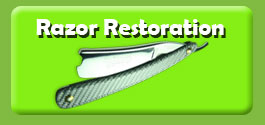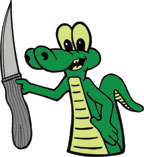

 |
 |
 |
 |
 |
 |
 |
 |
 |
 |
 |
 |
 |
 |
 |
 |
 |
 |
 |
 |
 |
 |
 |
 |
 |
 |
 |
 |
 |
 |
 |
 |
 |
 |
 |
 |
 |
 |
 |
 |
 |
 |
 |
 |
 |
 |
 |
 |
 |
Sharpening FAQ's 
Frequently Asked Questions About Sharpening!Facts About Knife Sharpening Question) Skilled sharpening services remove metal each time they sharpen? Question) Knife sharpening or tool grinding is best done by professionals? Question) Are stamped blades as sharp as forged blades? General Sharpening KnowledgeQuestion) Does a sharpening steel sharpen? Steels are available in a variety of grits from rough to smooth, including the use of diamonds. But, regardless of proper steel use, all knives will need to be re-sharpened at some point. Question) What should a serrated knife be used for? Serrated knives have become popular steak knives because the serrations tend to not cut into fine-china and stoneware vs. a fine edge knife that tends to cut into the plates finish. Serrated knives are also used to cut rope, seatbelts and small wood projects. Question) What are the different types of cutlery knife shapes? German: The most common Western shape is the German blade. The edge of German blades curves up towards the tip. The curve makes using a rocking motion to chop foods much easier. The blade can stay in constant contact with the cutting surface give most users steady control. French: French blades a basically triangular. The cutting edge is much straighter from the heel to tip. French cutting techniques generally employ more slicing motions rather than the rocking motions. Naturally, the French think it is the best way to go, but it's really a matter of preference. Neither is necessarily superior; but German blades are popular in most places other than France. Japanese: The Japanese blade design has become much more popular with Western users in recent years. The most popular Japanese chef knife is the Santoku. It is best recognized by it's sheepsfoot shape. The edge is straight and level with the spine of the knife curving down to meet the edge. It has a bit of a "claw" or "talon" shape. Question) What are the different types of knife steel? Carbon Steel: Mainly a combination of iron with about 1% carbon added. But, that figure can vary slightly. The addition of carbon to the alloy makes the blade very hard so it holds an edge fairly well. Though this hardness can also make it more easily breakable. Plus, it can be vulnerable to rust and stains. True carbon steel knives are not in wide use today. Stainless Steel: HIGH CARBON Stainless steel is the industry standard when describing high quality cutlery. Modern technology has brought a variety of formulas for development and production of stainless steel that includes adding enough carbon along with other alloys including, chromium, vanadium, nickel, etc that give knives their strong edge. The high carbon content will increase performance of knives and makes it easier to re-sharpen as needed. High Carbon Stainless Steel knives are resistant to corrosion and staining. Laminated (Damascus): These blades are made from different types of metals sandwiched together. Many feel this method is the best of both worlds allowing the blade to have the rigidity needed for strength but retain enough flexibility to resist chipping or breaking. The edges can also be harder and ground to a more defined edge. General Knife Care KnowledgeQuestion) Should I store my knife in my leather sheath? Question) What type of cutting board should I use? The next best cutting board surface is the plastic cutting boards. These cutting boards are relatively easy on knife edges and are practical to use. Unlike a wooden cutting board, the plastic boards can be tossed into a dishwasher for sanitizing. These cutting boards are also available in many sizes and are priced economically. The last choice in cutting boards would be glass, marble or ceramic boards. These cutting surfaces are just too hard for knives. Constant chopping and slicing on these boards will dull even the highest quality kitchen knives. |

San Diego Mobile Sharpening Services | Cutlery Sharpened | Knife Sharpening | Garden Tool Sharpening | Hand Tool Sharpening
Mail-Order Sharpening | Ski Sharpening | Lawn Mower Blades Sharpened | Tool Engraving | Knife Reconditioning
Chula Vista Knife Supply | Contact Sharpening Shack | Pick-Up & Delivery Sharpening Service | Paper Cutter Sharpening | Sitemap
Chain Saw Sharpening | Hedge Trimmer Sharpening | Golf Club Sharpening | Axe Sharpening | Plane & Chisel Sharpening

